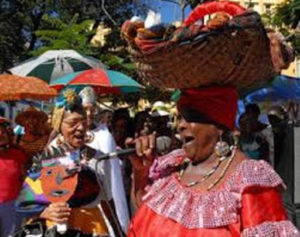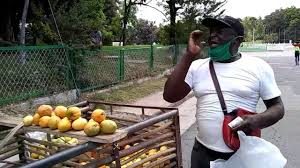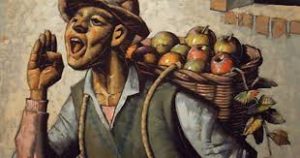 SANTIAGO DE CUBA: RESEÑA DE SU “FESTIVAL DEL PREGÓN” CARNAVALESCO.
SANTIAGO DE CUBA: RESEÑA DE SU “FESTIVAL DEL PREGÓN” CARNAVALESCO.
En Santiago de Cuba para la mitad del mes de Julio, este año no pudo celebrarse por la pandemia, las más céntricas calles de nuestra ciudad se convertierten en escenario del verso creativo para la promoción de mercancías, que es también patrimonio santiaguero, durante la celebración del llamado “Festival del Pregón”. Una atractiva propuesta que congrega a los más reconocidos pregoneros de la cabecera provincial, quienes con cestas y carretones cargados con los más disímiles productos, hacen derroche de la gracia de estilos diversos a lo largo de la Avenida Victoriano Garzón y por toda la ciudad.
RESEÑAS SOBRE EL PREGÓN Y EN QUE SE HA CONVERTIDO.
Una de las manifestaciones más populares dentro del carnaval santiaguero es el pregón. Deciamos algunos años atrás “El pregón es como el piropo, se acepta y se admira si aporta al gracejo popular; se rechaza si es agresivo o soez. El pregón no es privativo del carnaval, pero este jolgorio es su espacio predilecto, por eso entre las múltiples iniciativas del carnaval santiaguero, surgió la idea de realizar el Festival.
Las melodiosas voces de los pregoneros con sus anuncios imaginativos, verdaderas joyas del arte popular, de su capacidad de síntesis, de improvisación y gracia, llenaron de júbilo las calles de esta ciudad hecha de historias y de ritmos. Muchos curiosos ocuparon sus puestos para disfrutar de los anuncios de los pregoneros, quienes ofertan mercancías de todo tipo, aunque la intención esencial más que vender, es defender la práctica de una tradición popular añeja y auténtica”.
Los efectos del pregón son contagiosos; su autenticidad está probada. Poetas como Nicolás Guillen y Miguel Barnet, alabaron sus valores artísticos; y este último considera al pregón como un capítulo fundamental del folclor criollo. El pregón invadió la música y trascendió las fronteras nacionales, alimentó canciones que invitan a degustar las frutas del Caney, a consumir pasteles o un rico panqué; pero, su influencia capital se denomina: «El manisero», la mundialmente famosa canción-pregón de Moisés Simons.
El Festival del Pregón convirtió a Santiago en una fiesta, en un espacio saludable del verano. Pero: ¿qué sucede en la actualidad?.
Sucede, que se ha desarrollado una especie de anunciantes quienes gritan a voz en cuello, a cualquier hora y en cualquier sitio sus mercancías. Son pocos imaginativos y con sus alardes corrompen una tradición que nos enorgullece. Cuando se realice un nuevo festival ojalá ninguno de estos supuestos pregoneros participe, con soportarlos en el barrio es suficiente.
Hemos escuchado voces que se alegran de que este año no haya carnavales por la pandemia, para que no haya pregones. Es un criterio atendible, solo debemos reparar en un dato relevante. Ya dijimos que el pregón no se circunscribe al carnaval. En el barrio solíamos escuchar los cantos melodiosos de los vendedores de frutas – ahora la moda es el mango- de artesanías y hasta de periódicos. En estos vendedores la función del pregón más que vender consiste en darle al producto un valor adicional superior a su utilización práctica.
Al frente de la legión de los nuevos pregoneros, de los depredadores, están los vendedores de pan que ya ni pregoneros son porque han sustituido los cantos rítmicos con unos silbatos abominables que interrumpen la tranquilidad del barrio y erizan los oídos aún menos sensibles; después están los vendedores de viandas y vegetales no menos gritones, en este grupo solo los vendedores de frutas que repiten estribillos melodiosos conservan algunas de la virtudesdel género: al resto no puede considerárseles pregoneros, sería una falta de respeto para el pregón.
Creo que lo que está en crisis más que el pregón es una forma de concebirlo que lo envilece o lo desnaturaliza y como sus practicantes no son pregoneros tenemos la esperanza de que en el próximo carnaval, si los vendedores del barrio no han acabado con nuestros oídos, podamos disfrutar de buenos pregones como los que improvisaba Berta la pregonera o simplemente de pregones. De modo que habrá que soportarlos en el barrio, pero no en el carnaval. Y si quieren ganarse el puesto tendrán que enmendar su estilo, solo le exigimos que sean auténticos, de lo contrariono podemos llamarle pregoneros sería una injusticia contra una manifestación auténtica de la cultura popular del país y particularmente de Santiago de Cuba.
 SANTIAGO DE CUBA: REVIEW OF ITS “FESTIVAL DEL PREGÓN” CARNAVALESCO.
SANTIAGO DE CUBA: REVIEW OF ITS “FESTIVAL DEL PREGÓN” CARNAVALESCO.
In Santiago de Cuba for the middle of the month of July, this year it could not be celebrated due to the pandemic, the most central streets of our city become the scene of the creative verse for the promotion of merchandise, which is also Santiago’s heritage, during the celebration of the so-called “Festival of the Proclamation”. An attractive proposal that brings together the most renowned town criers of the provincial capital, who with baskets and carts loaded with the most dissimilar products, make a waste of the grace of diverse styles along Victoriano Garzón Avenue and throughout the city.
REVIEWS ABOUT EL PREGON AND WHAT IT HAS BECOME.
One of the most popular manifestations within the Santiago carnival is the proclamation. We said a few years ago “The proclamation is like the compliment, it is accepted and admired if it contributes to the popular wit; it is rejected if it is aggressive or rude. The proclamation is not exclusive to the carnival, but this revelry is its favorite space, that is why among the many initiatives of the Santiago Carnival, the idea of holding the festival arose.
The melodious voices of the town criers with their imaginative announcements, true jewels of popular art, their capacity for synthesis, improvisation and grace, filled the streets of this city made of stories and rhythms with joy. Many curious people took their places to enjoy the announcements of the town criers, who offer merchandise of all kinds, although the essential intention rather than selling, is to defend the practice of an old and authentic popular tradition ”.
The effects of the proclamation are contagious; its authenticity is proven. Poets like Nicolás Guillen and Miguel Barnet praised his artistic values; and the latter considers the proclamation as a fundamental chapter of Creole folklore. The proclamation invaded music and transcended national borders, fueled songs that invite you to taste the Caney fruits, to consume cakes or a delicious pancake; but, its capital influence is called: “El manisero”, the world-famous song-proclamation of Moisés Simons.
The Proclamation Festival turned Santiago into a party, into a healthy summer space. But: what is happening today?
It happens that a kind of advertisers has developed who shout their merchandise at any time and anywhere. They are unimaginative and with their bragging, they corrupt a tradition that makes us proud. When a new festival is held, I hope none of these supposed town criers will participate, just supporting them in the neighborhood is enough.
We have heard voices that are happy that this year there are no carnivals due to the pandemic so that there are no cries. It is an understandable criterion, we only have to repair a relevant data. We have already said that the proclamation is not limited to the carnival. In the neighborhood we used to listen to the melodious songs of the fruit vendors – now the fashion is mango – of handicrafts and even newspapers. In these sellers, the function of the proclamation rather than selling is to give the product an added value greater than its practical use.
At the forefront of the legion of the new town criers, the predators, are the bread sellers who are not even town criers anymore because they have replaced rhythmic songs with abominable whistles that interrupt the tranquility of the neighborhood and make even less sensitive ears prickle; then there are the vendors of viands and vegetables who are no less loud, in this group only the fruit vendors who repeat melodious refrains retain some of the virtues of the genre: the rest cannot be considered town criers, it would be a lack of respect for the proclamation.
I think that what is in crisis more than the proclamation is a way of conceiving it that debases or denatures it and since its practitioners are not town criers we have the hope that in the next carnival if the neighborhood vendors have not finished with our ears, we can enjoy good proclamations like the ones improvised by Berta la pregonera or simply proclamations. So they will have to be endured in the neighborhood, but not at the carnival. And if they want to win the position they will have to amend their style, we only demand that they are authentic, otherwise, we can call them town criers, it would be an injustice against an authentic manifestation of the popular culture of the country and particularly of Santiago de Cuba.
Agencies/ Wiki/ Radio Mambi/ Osmar Alvarez/ Internet Photos/ YouTube/ Arnoldo Varona/ www.TheCubanHistory.com
THE CUBAN HISTORY, HOLLYWOOD.











